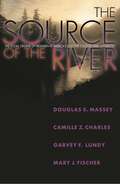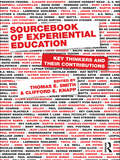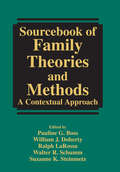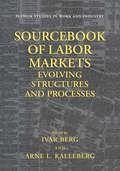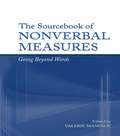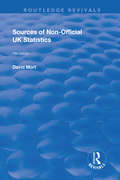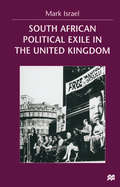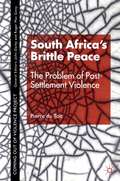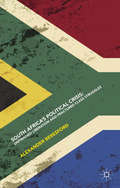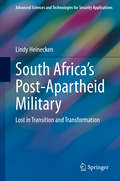- Table View
- List View
The Source of the River: The Social Origins of Freshmen at America's Selective Colleges and Universities
by Douglas S. Massey Camille Z. Charles Garvey Lundy Mary J. FischerAfrican Americans and Latinos earn lower grades and drop out of college more often than whites or Asians. Yet thirty years after deliberate minority recruitment efforts began, we still don't know why. In The Shape of the River, William Bowen and Derek Bok documented the benefits of affirmative action for minority students, their communities, and the nation at large. But they also found that too many failed to achieve academic success. In The Source of the River, Douglas Massey and his colleagues investigate the roots of minority underperformance in selective colleges and universities. They explain how such factors as neighborhood, family, peer group, and early schooling influence the academic performance of students from differing racial and ethnic origins and differing social classes. Drawing on a major new source of data--the National Longitudinal Survey of Freshmen--the authors undertake a comprehensive analysis of the diverse pathways by which whites, African Americans, Latinos, and Asians enter American higher education. Theirs is the first study to document the different characteristics that students bring to campus and to trace out the influence of these differences on later academic performance. They show that black and Latino students do not enter college disadvantaged by a lack of self-esteem. In fact, overconfidence is more common than low self-confidence among some minority students. Despite this, minority students are adversely affected by racist stereotypes of intellectual inferiority. Although academic preparation is the strongest predictor of college performance, shortfalls in academic preparation are themselves largely a matter of socioeconomic disadvantage and racial segregation. Presenting important new findings, The Source of the River documents the ongoing power of race to shape the life chances of America's young people, even among the most talented and able.
Sourcebook of Experiential Education: Key Thinkers and Their Contributions
by Thomas E. SmithExperiential education is a philosophy and methodology for building knowledge, developing skills, and clarifying values by engaging learners in direct experience and focused reflection. To understand experiential education, what should one be reading? This sourcebook introduces philosophers, educators, and other practitioners whose work is relevant to anyone seeking answers to this question. Following brief snapshots of John Dewey and Kurt Hahn, the book is organized in four sections: Philosophers and Educational Theorists Nature Educators and Outdoor Educators Psychologists and Sociologists School and Program Founders. Each chapter focuses on an individual whose philosophy and practice exemplify a biographical and historical model for reaching a deeper understanding of experiential education. An appendix includes short biographical sketches of forty-five additional people whose contributions to experiential education deserve a closer look. This volume provides a much-needed overview and foundations for the field – for students in courses addressing experiential education, challenge education, outdoor experiential education, recreation education, and related fields; for learning theorists and curriculum specialists; for experiential educators; and for educational philosophers.
Sourcebook of Experiential Education: Key Thinkers and Their Contributions
by Thomas E. Smith Clifford E. KnappExperiential education is a philosophy and methodology for building knowledge, developing skills, and clarifying values by engaging learners in direct experience and focused reflection. To understand experiential education, what should one be reading? This sourcebook introduces philosophers, educators, and other practitioners whose work is relevant to anyone seeking answers to this question. Following brief snapshots of John Dewey and Kurt Hahn, the book is organized in four sections: Philosophers and Educational Theorists Nature Educators and Outdoor Educators Psychologists and Sociologists School and Program Founders. Each chapter focuses on an individual whose philosophy and practice exemplify a biographical and historical model for reaching a deeper understanding of experiential education. An appendix includes short biographical sketches of forty-five additional people whose contributions to experiential education deserve a closer look. This volume provides a much-needed overview and foundations for the field – for students in courses addressing experiential education, challenge education, outdoor experiential education, recreation education, and related fields; for learning theorists and curriculum specialists; for experiential educators; and for educational philosophers.
Sourcebook of Family Theories and Methodologies: A Dynamic Approach
by Kari Adamsons April L. Few-Demo Christine M. Proulx Kevin RoyThis sourcebook is an unparalleled resource in the field of family science. It provides a comprehensive overview of both traditional and contemporary theories and methodologies to promote a greater understanding of increasingly complex family realities. It focuses on broad developments in research design and conceptualization, while also offering a historical perspective on developments in family science over time, particularly emerging theories from the past several decades. Each chapter summarizes and evaluates a major theory or methodological approach in the field, delving into its main principles; its debates and challenges; how it has evolved over time; its practical uses in policy, education, or further research; and links to other theories and methodologies. In highlighting recent research of note, chapters emphasize the potential for innovative future applications.Key areas of coverage include:· Risk and resilience, family stress, feminist, critical race, and social exchange theories.· Ambiguous loss, intersectionality, Queer, and family development theory.· Life course framework.· Biosocial theory and biomarker methods.· Symbolic interactionism.· Ethnography.· Mixed methods, participatory action research, and evaluation.
Sourcebook of Family Theories and Methods: A Contextual Approach
by Pauline Boss William J. Doherty Ralph LaRossa Walter R. Schumm Suzanne K. SteinmetzOrigins We call this book on theoretical orientations and methodological strategies in family studies a sourcebook because it details the social and personal roots (i.e., sources) from which these orientations and strategies flow. Thus, an appropriate way to preface this book is to talk first of its roots, its beginnings. In the mid 1980s there emerged in some quarters the sense that it was time for family studies to take stock of itself. A goal was thus set to write a book that, like Janus, would face both backward and forward a book that would give readers both a perspec tive on the past and a map for the future. There were precedents for such a project: The Handbook of Marriage and the Family edited by Harold Christensen and published in 1964; the two Contemporary Theories about theFamily volumes edited by Wesley Burr, Reuben Hill, F. Ivan Nye, and Ira Reiss, published in 1979; and the Handbook of Marriage and the Family edited by Marvin Sussman and Suzanne Steinmetz, then in production.
Sourcebook of Labor Markets: Evolving Structures and Processes (Springer Studies in Work and Industry)
by Ivar Berg Arne L. KallebergA distinguished roster of contributors considers the state of the art of the field at the turn of the 21st century and charts an ambitious agenda for the future. Following what the editors describe as an `evolutionist' approach to the study of labor markets, the chapters address issues of continuity and discontinuity in a wide range of topics including: markets and institutional structures; employment relations and work structures; patterns of stratification in the United States; and public policies, opportunity structures, and economic outcomes.
The Sourcebook of Nonverbal Measures: Going Beyond Words
by Valerie ManusovThe Sourcebook of Nonverbal Measures provides a comprehensive discussion of research choices for investigating nonverbal phenomena. The volume presents many of the primary means by which researchers assess nonverbal cues. Editor Valerie Manusov has collected both well-established and new measures used in researching nonverbal behaviors, illustrating the broad spectrum of measures appropriate for use in research, and providing a critical resource for future studies.With chapters written by the creators of the research measures, this volume represents work across disciplines, and provides first-hand experience and thoughtful guidance on the use of nonverbal measures. It also offers research strategies researchers can use to answer their research questions; discussions of larger research paradigms into which a measure may be placed; and analysis tools to help researchers think through the research choices available to them.With its thorough and pragmatic approach, this Sourcebook will be an invaluable resource for studying nonverbal behavior. Researchers in interpersonal communication, psychology, personal relationships, and related areas will find it to be an essential research tool.
The Sourcebook of Nonverbal Measures: Going Beyond Words
by Valerie Lynn ManusovThe Sourcebook of Nonverbal Measures provides a comprehensive discussion of research choices for investigating nonverbal phenomena. The volume presents many of the primary means by which researchers assess nonverbal cues. Editor Valerie Manusov has collected both well-established and new measures used in researching nonverbal behaviors, illustrating the broad spectrum of measures appropriate for use in research, and providing a critical resource for future studies.With chapters written by the creators of the research measures, this volume represents work across disciplines, and provides first-hand experience and thoughtful guidance on the use of nonverbal measures. It also offers research strategies researchers can use to answer their research questions; discussions of larger research paradigms into which a measure may be placed; and analysis tools to help researchers think through the research choices available to them.With its thorough and pragmatic approach, this Sourcebook will be an invaluable resource for studying nonverbal behavior. Researchers in interpersonal communication, psychology, personal relationships, and related areas will find it to be an essential research tool.
Sources of Non-official UK Statistics (Routledge Revivals)
by D. Mort Leona Siddall Wendy WilkinsThis title was first published in 2002: This volume gives details of nearly 1000 publications and services (including electronic publications) produced by trade associations, professional bodies, banks, consultants, employers' federations, forecasting organizations and others, together with statistics appearing in trade journals and periodicals. Titles and services are listed alphabetically by publisher and each entry contains information, where available, on subject, content and source of statistics, as well as frequency and cost, and address, telephone and fax details for further information. This updated edition also includes details of internet sites and information on whether statistics are available on those sites.
Sources of Non-official UK Statistics
by D. Mort Leona Siddall Wendy WilkinsThis title was first published in 2002: This volume gives details of nearly 1000 publications and services (including electronic publications) produced by trade associations, professional bodies, banks, consultants, employers' federations, forecasting organizations and others, together with statistics appearing in trade journals and periodicals. Titles and services are listed alphabetically by publisher and each entry contains information, where available, on subject, content and source of statistics, as well as frequency and cost, and address, telephone and fax details for further information. This updated edition also includes details of internet sites and information on whether statistics are available on those sites.
Sources of Non-official UK Statistics
by David MortThis title was first published in 2002: This volume gives details of nearly 1000 publications and services (including electronic publications) produced by trade associations, professional bodies, banks, consultants, employers' federations, forecasting organizations and others, together with statistics appearing in trade journals and periodicals. Titles and services are listed alphabetically by publisher and each entry contains information, where available, on subject, content and source of statistics, as well as frequency and cost, and address, telephone and fax details for further information. This updated edition also includes details of internet sites and information on whether statistics are available on those sites.
The Sources Of Social Power: A History Of Power From The Beginning To Ad 1760
by Michael MannDistinguishing four sources of power in human societies - ideological, economic, military and political - The Sources of Social Power traces their interrelations throughout human history. In this first volume, Michael Mann examines interrelations between these elements from neolithic times, through ancient Near Eastern civilizations, the classical Mediterranean age and medieval Europe, up to just before the Industrial Revolution in England. It offers explanations of the emergence of the state and social stratification; of city-states, militaristic empires and the persistent interaction between them; of the world salvation religions; and of the particular dynamism of medieval and early modern Europe. It ends by generalizing about the nature of overall social development, the varying forms of social cohesion and the role of classes and class struggle in history. First published in 1986, this new edition of Volume 1 includes a new preface by the author examining the impact and legacy of the work.
South African AIDS Activism and Global Health Politics (Global Ethics)
by M. MbaliSouth Africa has the world's largest number of people living with HIV. This book offers a history of AIDS activism in South Africa from its origins in gay and anti-apartheid activism to the formation and consolidation of the Treatment Action Campaign (TAC), including its central role in the global HIV treatment access movement.
South African Political Exile in the United Kingdom
by Mark IsraelAfter 1948 many opponents of apartheid were forced out of South Africa. This accessible and readable account draws upon interviews with many of those involved to examine how those activists who came to the United Kingdom developed political organisations, social networks, ideologies and identities that supported their time in exile. It examines the Anti-Apartheid Movement and the African National Congress in exile and documents the violent attempts by the South African government to control exile activity. Finally, it investigates how exiles came to terms with the possibility that they might return.
South African Schooling: A Study of the Present Situation and Future Possibilities (Policy Implications of Research in Education #10)
by Nic Spaull Jonathan D. JansenThis volume brings together many of South Africa’s leading scholars of education and covers the full range of South African schooling: from financing and policy reform to in-depth discussions of literacy, numeracy, teacher development and curriculum change. The book moves beyond a historical analysis and provides an inside view of the questions South African scholars are now grappling with: Are there different and preferential equilibria we have not yet thought of or explored, and if so what are they? In practical terms, how does one get to a more equitable distribution of teachers, resources and learning outcomes? While decidedly local, these questions resonate throughout the developing world.South Africa today is the most unequal country in the world. The richest 10% of South Africans lay claim to 65% of national income and 90% of national wealth. This is the largest 90-10 gap in the world, and one that is reflected in the schooling system. Two decades after apartheid it is still the case that the life chances of most South African children are determined not by their ability or the result of hard-work and determination, but instead by the colour of their skin, the province of their birth, and the wealth of their parents. Looking back on almost three decades of democracy in South Africa, it is this stubbornness of inequality and its patterns of persistence that demands explanation, justification and analysis. "This is a landmark book on basic education in South Africa, an essential volume for those interested in learning outcomes and their inequality in South Africa. The various chapters present conceptually and empirically sophisticated analyses of learning outcomes across divisions of race, class, and place. The book brings together the wealth of decades of research output from top quality researchers to explore what has improved, what has not, and why." Prof Lant Pritchett, Harvard University “There is much wisdom in this collection from many of the best education analysts in South Africa. No surprise that they conclude that without a large and sustained expansion in well-trained teachers, early childhood education, and adequate school resources, South Africa will continue to sacrifice its people’s future to maintaining the privileges of the few.” Prof Martin Carnoy, Stanford University "Altogether, one can derive from this very valuable volume, if not an exact blueprint for the future, then certainly at least a crucial and evidence-based itinerary for the next few steps.” Dr Luis Crouch, RTI
South African Urban Change Three Decades After Apartheid: Homes Still Apart? (GeoJournal Library)
by Anthony Lemon Ronnie Donaldson Gustav VisserThis book provides an analysis of South African urban change over the past three decades. It draws on a seminal text, Homes Apart, and revisits conclusions drawn in that collection that marked the final phases of urban apartheid. It highlights changes in demography, social as well as economic structure and their differential spatial expression across a range of urban sites in South Africa. The evidence presented in this book points to a very complex set of narratives in urban South Africa and one that cannot be reduced to a singular statement so the conclusions of the various investigations are in many ways open. As urban apartheid represented one clear outcome, its post-apartheid urban legacies varies greatly from city to city. As such this book is a great resource to students and academics focused on urban change in South African cities since the demise of apartheid, and scholars of urban policy-making in South Africa and Southern urbanists generally.
South Africa's Brittle Peace: The Problem of Post-Settlement Violence (Ethnic and Intercommunity Conflict)
by P. ToitSouth Africa has succeeded in establishing a democracy, but has yet to eliminate public violence from society. This book takes up the issue of post-settlement violence and ways of consolidating the newly found democratic peace. The role of negotiated institutions such as the new police force, economic factors relevant to the anticipated 'peace dividend', external factors such as arms smuggling networks, popular responses to rising threats to physical safety, and symbolic factors in enhancing the capacity of the state to deal with this issue are examined.
South Africa’s Energy Transition (Progressive Energy Policy)
by Andrew LawrenceThis book provides a succinct overview of the evolution of policies addressing energy and climate justice in South Africa. Drawing on a range of analytical perspectives, including socio-technical studies, just transitions, and critical political economy, it explains why South Africa’s energy transition from a coal-dependent, centralised power generation and distribution system has been so slow, and reveals the types of socio-political inequalities that persist across regimes and energy sources. Topics explored include critical approaches to the South African state and its state-owned energy provider, Eskom; the political ecologies of coal and water; the politics of non-renewable energy alternatives; as well as the trajectory and fate of the Renewable Energy Independent Power Producers Procurement Programme (REIPPPP), the country’s major renewable energy policy. The book concludes with reflections on alternative, neglected energy and development paths, suggesting how the political economy of South Africa’s energy system could be further transformed for the better.
South Africa's Future: From Crisis to Prosperity
by A. GinsbergUnemployment is growing. Crime is on the increase. The currency has fallen. The initial euphoria following South Africa's transition to democracy is waning as people become disillusioned with the state of the economy and government's lack of delivery on polices and promises. Where does South Africa go from here? It is not all doom and gloom and there is hope for the future. Anthony Ginsberg offers solutions to the fundamental problem of rising unemployment, crime, homelessness and poverty, all excerbated by high taxes, draconian tariffs and stagnant foreign investment. He encourages us to become informed and aware before we criticise. This book is aimed at everyone interested in contributing to South Africa' s future as a prosperous nation in the benefit of all her citizens.
South Africa’s Political Crisis: Unfinished Liberation and Fractured Class Struggles
by Alexander BeresfordSouth Africa's current political upheavals are the most significant since the transition from apartheid. Its powerful trade unions are playing a central role, and the political direction they take will have huge significance for how we understand the role of labour movements in struggles for social justice in the twenty-first century.
South Africa's Post-Apartheid Military: Lost in Transition and Transformation (Advanced Sciences and Technologies for Security Applications)
by Lindy HeineckenThis timely book examines how the South African National Defence Force has adapted to the country’s new security, political and social environment since 1994. In South Africa’s changed political state, how has civilian control of the military been implemented and what does this mean for ‘defence in a democracy’? This book presents an overview of the security environment, how the mission focus of the military has changed and the implications for force procurement, force preparation, force employment and force sustainability. The author addresses other issues, such as: · the effect of integrating former revolutionary soldiers into a professional armed force · the effect of affirmative action on meritocracy, recruitment and retention · military veterans, looking at the difficulties they face in reintegrating back into society and finding gainful employment · gender equality and mainstreaming · the rise of military unions and why a confrontational, instead of a more corporatist approach to labour relations has emerged · HIV/AIDS and the consequences this holds for the military in terms of its operational effectiveness. In closing, the author highlights key events that have caused the SANDF to become ‘lost in transition and transformation’, spelling out some lessons learned. The conclusions she draws are pertinent for the future of defence, security and civil-military relations of countries around the world.
South American Childhoods: Neoliberalisation and Children’s Rights since the 1990s (Studies in Childhood and Youth)
by Ana Vergara del Solar Valeria Llobet Maria Letícia NascimentoThis edited volume concerns childhood throughout South America after the 1990s, a period and territory of special complexity marked by the beginning—or intensification of—political neoliberalisation throughout the region. The decade also saw the ratification of the International Convention on Rights of the Child and post-dictatorial processes of political and social democratisation. The editors of this book explore the tension this juxtaposition has generated between logics and processes of dissimilar orientations. Within this framework, chapters investigate the neoliberalisation and institutionalisation of children’s rights and consider similarities and differences with respect to other regions. They also explore changes in schools and educational systems, as well as the phenomenon of the internal and external child and family migration.
South American Free Trade Area or Free Trade Area of the Americas?: Open Regionalism and the Future of Regional Economic Integration in South America
by Mario Esteban CarranzaThis title was first published in 2000: This work examines the hemispheric diplomacy after the Summits of the America in Miami (December 1994) and Santiago (April 1998), focusing on the strengthening of the South American position in the FTAA negotiations and the Brazilian proposal for a South American Free Trade Area (SAFTA). The book also looks at the implications of the preceding analysis for regional integration theory and international relations theory. The conclusion looks beyond "open regionalism" and considers three scenarios for US-South American relations after the Santiago Summit. First reassertion of US hegemony and signing of an FTAA agreement on schedule, second, erosion of US hegemony but continuing negotiations between North and South America for a "distant" FTAA, and finally, breakdown of the FTAA negotations and emergence of SAFTA as an alternative to the FTAA.
South American Free Trade Area or Free Trade Area of the Americas?: Open Regionalism and the Future of Regional Economic Integration in South America
by Mario Esteban CarranzaThis title was first published in 2000: This work examines the hemispheric diplomacy after the Summits of the America in Miami (December 1994) and Santiago (April 1998), focusing on the strengthening of the South American position in the FTAA negotiations and the Brazilian proposal for a South American Free Trade Area (SAFTA). The book also looks at the implications of the preceding analysis for regional integration theory and international relations theory. The conclusion looks beyond "open regionalism" and considers three scenarios for US-South American relations after the Santiago Summit. First reassertion of US hegemony and signing of an FTAA agreement on schedule, second, erosion of US hegemony but continuing negotiations between North and South America for a "distant" FTAA, and finally, breakdown of the FTAA negotations and emergence of SAFTA as an alternative to the FTAA.
South Asia Migration Report 2017: Recruitment, Remittances and Reintegration
by S. Irudaya RajanSouth Asians comprise over 15 per cent of all international migrating population, among the highest in the world. The countries of the Persian Gulf are perhaps still the largest recipients of migrant workers. A unique economy has developed between these two regions, with all South Asian nations being major beneficiaries and featuring among the top twenty countries receiving maximum remittances globally. The South Asia Migration Report 2017 is the first of its kind, documenting migration profiles, diaspora, recruitment and remittances, both in individual countries as well as the South Asian region as a whole. It also discusses skilled, unskilled and internal migrations. The volume: includes on-the-ground studies from six nations: India, Pakistan, Bangladesh, Sri Lanka, Nepal and Afghanistan; discusses public policy, effects of global recession on the region and its impact on migration; and examines the process of reintegration of returning migrants. This book will be indispensable for scholars and researchers of economics, development studies, migration and diaspora studies, labour studies and sociology. It will also be useful to policymakers and government institutions working in the area.
